True Grit: Beatty
March – April 2019
A person with true grit is often defined as someone who sticks to their goals, despite problems, setbacks, and failures. Having true grit means you are tough and determined…you have a steadfast core. In 2019, we are highlighting towns in Nevada that have that core strength. Not all towns in Nevada have huge shiny tourist draws; many exist along the highways that traverse our state, but aside from getting gas or grabbing food to go, they are easily overlooked. Nevada roads go on forever.
Small towns appear on the horizon, but are often quickly in the rearview mirror with little more than a passing thought about the town’s existence. And while tourism is the state’s largest industry—and the focus of this magazine—it is not why all towns in Nevada exist. This year, we honor some of those towns that defy easy description but stand tall in the desert, refusing to give into the sways of economic hardship or the passing of time. These towns bloom in the dirt, and they embody true grit.
This issue: Beatty.
Riding the tides of fortune, Beatty bets on a new kind of treasure in its hills.
BY MEGG MUELLER
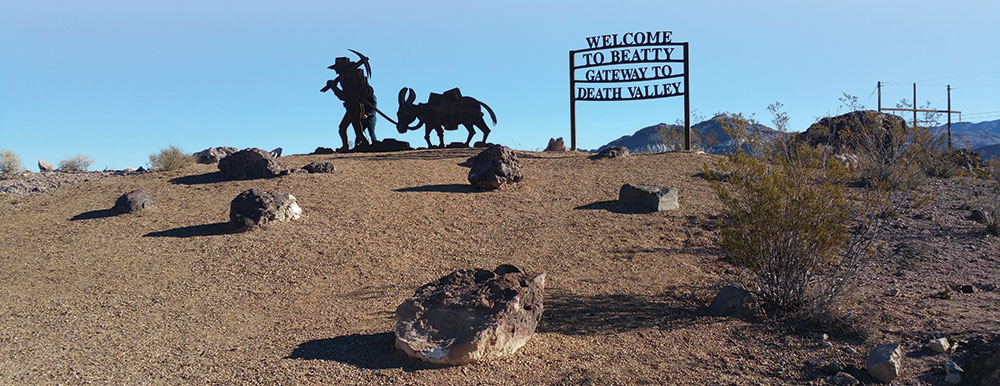
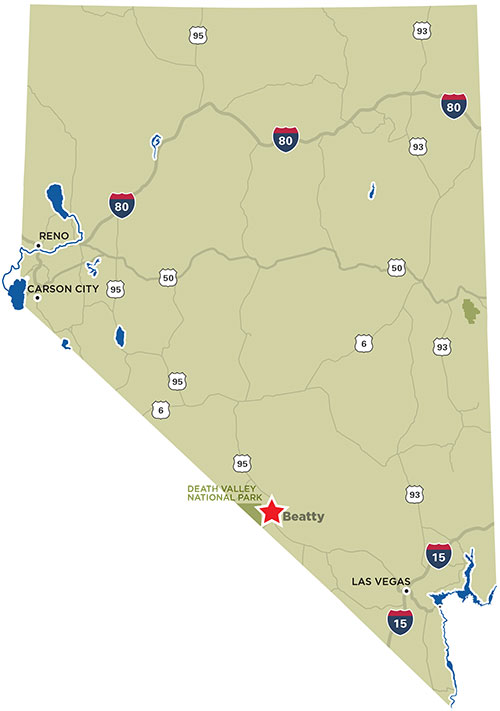 The cycle of life in many Nevada towns can be measured by the presence of mining activity. Ore found? Boom! Ore depleted? Bust! The town of Beatty has ridden the mining roller coaster for most of its existence, and it would be an oversimplification to say the lack of mining business has routinely dampened the town’s economy. From its very beginnings, however, Beatty has continued to go with the flow.
The cycle of life in many Nevada towns can be measured by the presence of mining activity. Ore found? Boom! Ore depleted? Bust! The town of Beatty has ridden the mining roller coaster for most of its existence, and it would be an oversimplification to say the lack of mining business has routinely dampened the town’s economy. From its very beginnings, however, Beatty has continued to go with the flow.
Beatty lies along the Amargosa River, 185 miles of the only free-flowing river in the Death Valley region of the Mojave Desert. In the 1870s, early settlers chose the lush Oasis Valley wisely; the river—nicknamed “the hide-and-seek river”—flows above ground for just a scant few miles, before it continues underground for 100 miles and finally peeks its watery head up again in Shoshone, California.

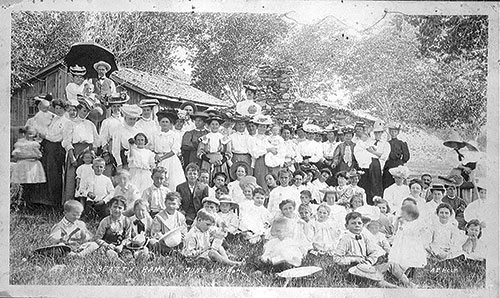
In 1896, Montillius Beatty settled in the Oasis Valley to ranch with his wife, and to occasionally work his claims. Beatty sprang to life in 1904 from the nearby gold discoveries, and as miners poured into Bullfrog and Rhyolite, the town became a supply station. The Tonopah and Tidewater Railroad came to town in 1906, followed shortly by the Bullfrog Goldfield Railroad. As people, hotels, and restaurants arrived, Beatty began calling itself the “Chicago of Nevada.” That moniker didn’t prove true in the long run, but the Amargosa River kept Beatty alive, long after towns such as Bullfrog and Rhyolite disappeared into the dust.
In 1933, Death Valley was declared a national monument and traffic to the area began to increase, and Beatty was sitting pretty just 7 miles from the park’s north entrance. Beatty continued to be a railroad hub until the 1940s when the trains stopped and the tracks were pulled up and used for the war effort, but the increasing vehicle traffic along U.S. Route 95 offered the town a new opportunity. Weary travelers began to take respite in the quaint town, filling their cars and bellies and often staying the night before making their way to the park. A new industry was taking shape.
Nellis Air Force Base and the Nevada National Security Site—aka the Nevada Test Site—both gave employment to the town in the 1940s and 1950s, and the growing popularity of Las Vegas, just 117 miles to the south, meant a steady stream of visitors coming through Beatty. A short-lived resurgence happened from 1988 to 1998 when mining returned to the area, but Beatty has held on through its boom and frightening bust years, and is today relying on visitors to Death Valley to keep the lights on. There is, however, more in the works for this beleaguered town than just being a gateway.
HIT ME AGAIN
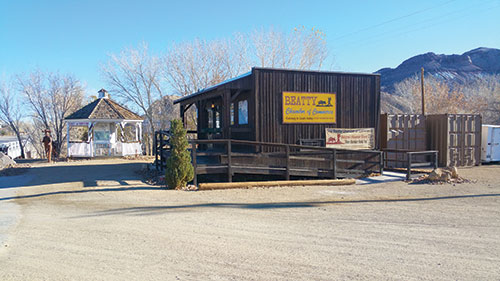
Despite the departure of Barrick Gold’s business in 1998, Beatty has only suffered a 12 percent loss of population in the last 20 years, which is remarkable when you consider that even the lone bank in town closed its doors in 2014.
“We’ve survived the mining bust by becoming the gateway to Death Valley,” Ann Marchand, president of the Beatty Chamber of Commerce, explains. “The two work in tandem. Beatty has been a hub for people wanting a more reasonable rate than properties in the park.”
Ann has lived in Beatty off and on since 1968 when she moved there as a child. She left Nevada for the Lone Star State briefly, then found herself returning to Beatty for work and for family. Today, along with her duties at the chamber, Ann has opened a couple of rental cabins. At first, she says, people were booking a day or two, but recently the stays are four-to-five days with guests from as far away as China, Korea, Italy, Denmark, and France.
In fact, since opening in September of last year, her cabins have hosted guests from 45 different countries.
“International visitors are going to Death Valley, and often they stay in Vegas,” Ann says. “But many want to get out to the national parks and see rural areas, too, so they stay a couple nights here, then move on to other parks like Zion and the Grand Canyon.”
Ann explains that as Beatty has focused its efforts as a tourism hub, it hasn’t left mining completely in the dust. A handful of mining companies—Coeur Rochester included—are currently drilling in the area, looking for enough ore to make full-scale mining viable again. The price of gold per ounce coupled with the amount of gold found in the samples will determine if Beatty becomes a mining town once more.

TIPPING THE SCALES
The boon that mining discoveries bring is considerable: everything from help building schools to donations of fire trucks and the like, but the obvious advantage is good paying jobs. According to Ericka Gerling, treasurer of the five-member advisory board that works with the Nye County commissioners to govern the town, the mines generally employ a couple hundred people, both residents and those who move to town for the jobs. Ericka has lived in Beatty for 40 years and raised two sons there. She says one of the concerns the community is focused on is making sure the residents of Beatty are prepared for the opportunities mining can bring.
“We want people to be able to get a better paying job,” Ericka says. “Workforce development is going to be a very big deal for this community and we’re talking with the mining companies—or whatever industry may come to town—about how they can help.”
The optimism surrounding the potential economic boost is tapered slightly, Ericka notes, by the knowledge that mining is always a temporary industry. Mines may be profitable for 5 years or 50 but eventually, the ore well will run dry.
Her thoughts are echoed by resident, businessman, and recreational activist David Spicer.
“We want to make partners out of these people. They all recognize they are going to be there temporarily,” David says. “After they go, we have to have stability and jobs. It’s not out of line to ask people to get involved in backing the towns they affect.”
David was born in Beatty and has seen the valley’s fortunes rise and fall. He works his family’s 320-acre ranch just outside town, and has contracts with mining companies and knows the positive impact they can have, but he thinks the Oasis Valley has another gem to offer: outdoor recreation.
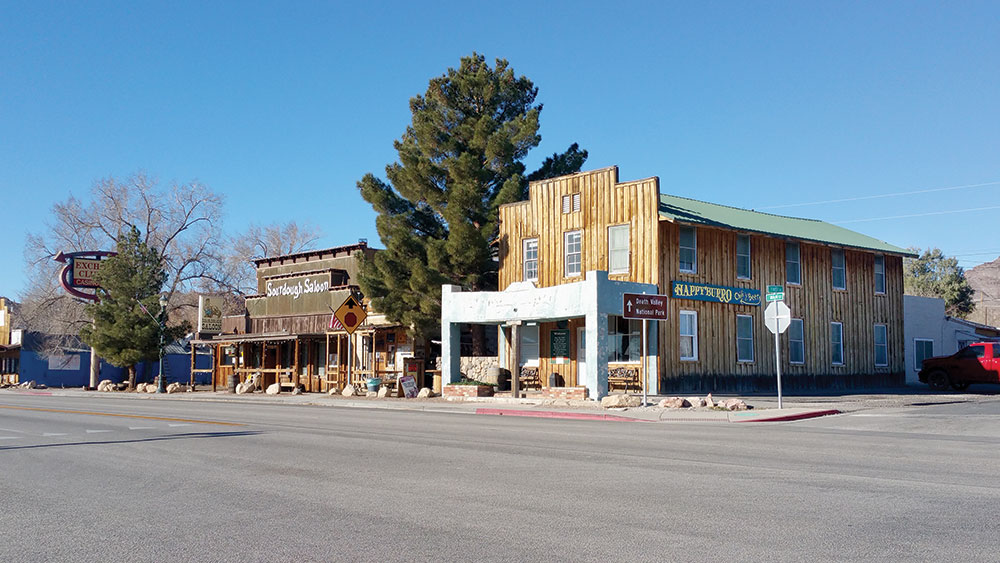
GATEWAY TO ADVENTURE
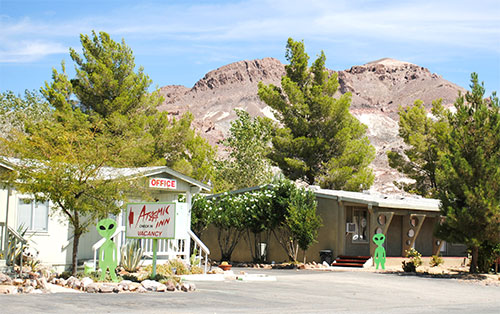
Beatty has long called itself the “Gateway to Death Valley,” and while servicing tourists’ needs is a strong economic driver, Ericka, David, and Ann all mention the expanding market for recreational tourism. The Oasis Valley is ripe for adventurers with miles and miles of roads and trails in the surrounding hills, a plethora of old mining locations and ghost towns (see page 36 for more on those), and vistas for days.
David has been promoting the area as a mountain bike and off-highway vehicle (OHV) destination for years. He’s created miles of mountain bike trails on his ranch that are open to the public, hosted two Tough Mudder events, three regional Burning Man events, and will soon host a National Interscholastic Cycling Association event that will bring about 150 young people to the area. The local Veterans of Foreign Wars chapter hosts the annual Bullfrog Historical Mining District Poker Run, which brings a couple hundred participants each year to wander the hills in their OHVs, ATVs, Jeeps, and more, just for the pleasure of driving off-road and discovering new sites.
“We’re getting more people coming that are into off-roading,” Ann notes. “People are coming to drive around to see the mining camps and the limestone formations.”
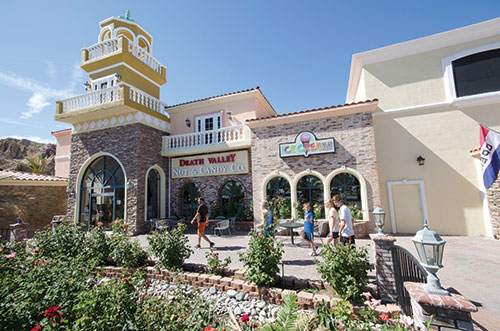
The business of outdoor recreation is a serious one and the potential for making money is also serious, but as David reveals it’s a process that encompasses many moving parts to be successful. While the area’s beauty is a given, it takes more than a photo to get visitors to put Beatty on their list of places to ride or go off-roading. It takes trail maps, permission for land acquisition and usage, an infrastructure that supports the needs of the outdoor tourist (bike shops, rental stores, restaurants, etc.), and a community that is ready to make all that happen.
“Nye County has some restrictions other counties don’t (in terms of land acquisition and permissions), but there’s no reason we can’t do this,” David says. “We can enjoy the windfall of people coming to enjoy the outdoor opportunities we have.”
The growth of outdoor recreation isn’t just about making a quick buck selling $6 coffee to tourists with expensive bikes. To David, it’s about creating a plan for the future survival of his hometown, and his home state. Things like bike trails, poker runs, and Burning Man festivals lead the way to new visitors and new ideas. He’s been approached about music festivals and art festivals, ultra marathons, and more. For Ann, Ericka, and David the excitement comes when those ideas turn into new revenue streams which lead to things like full classrooms, new residents with new skills and ideas, and a growing economy.
“It’s so important to diversify Nevada and bring income to those towns that are depressed right now,” he says.
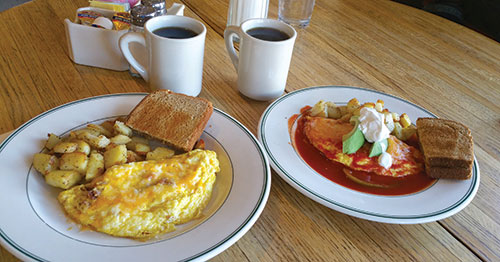
Some local business owners have committed to that diversification, with new service businesses being planned along with other recreational opportunities, and to people like David, that’s what this is about.
“We’re all working together as a community to make that future. We’ve made a lot of progress. We’re not a success yet, but we’re at the start of it. We’re building foundations others can use,” he says.
Ann agrees: “We’ve been like this little island left in time for a long, long time. But the future is catching up to us fast. Now things that we thought about in passing, we have to think about in a concrete way.”
PLACES WE LOVE IN BEATTY
EAT: Gema’s Wagon Wheel Café
SHOP: Death Valley Nut and Candy Company
STAY: Atomic Inn
PLAY: Trails Oasis Valley

